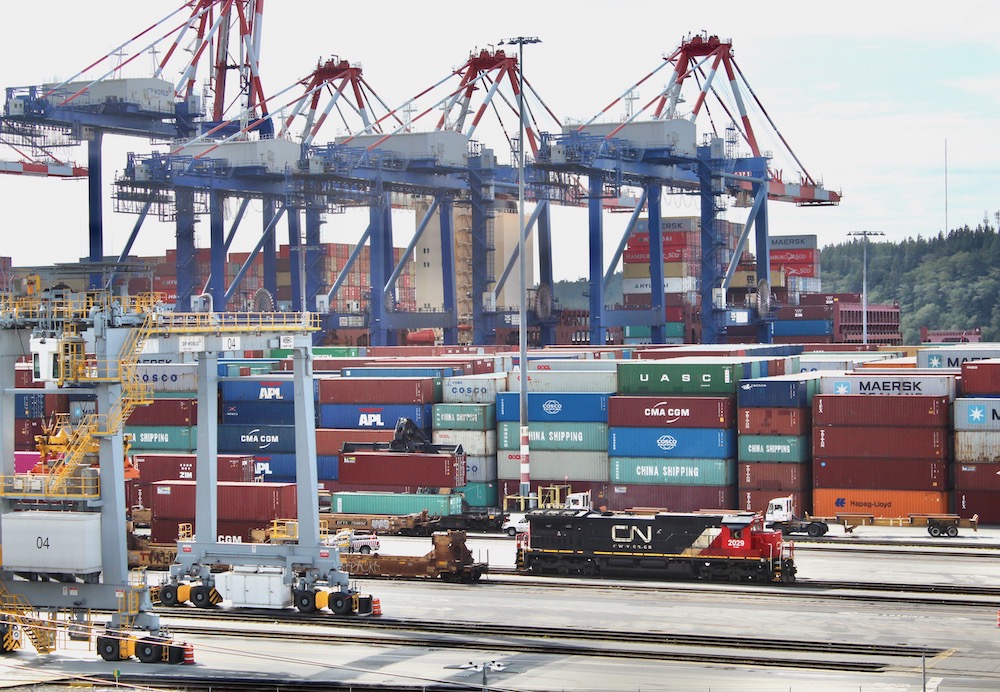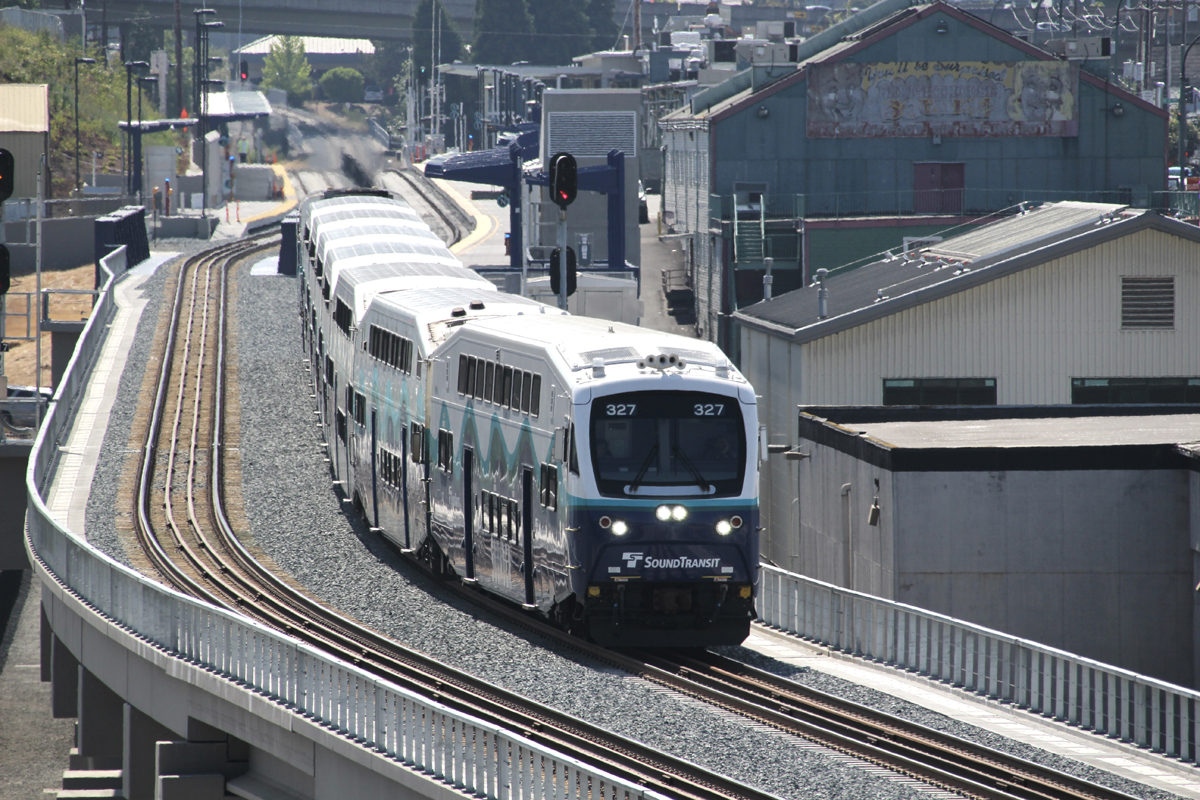
MONTREAL — Canadian National envisions the day when its main line to the Port of Prince Rupert, British Columbia, will host 50 trains per day.
“Our capacity right now on that line is about 25 trains a day,” CN CEO Tracy Robinson told an investor conference on Wednesday. “We’re running a little bit below that right now, so we have some capacity. But if you look out at all of the opportunities we see … over a longer period of time we could see building that line out in support of all those growth initiatives by another 25 trains, so doubling the capacity of that line.”
The container terminal at Rupert can currently handle 1.6 million TEU, or twenty-foot equivalent units, but by the end of next year will be able to accommodate 1.8 million after an expansion project is completed.
The addition of a second container terminal, currently envisioned for 2030-31, Robinson says, would give Prince Rupert the capacity to handle four million TEU per year, rivaling the current capacity of Vancouver, Canada’s busiest container port. Last year Vancouver handled 3.6 million TEU. The Roberts Bank Terminal 2 project, which last month gained government approval, will add 2.4 million TEU to Vancouver’s capacity in the early 2030s.
Prince Rupert has a community that supports the port and further development, Robinson notes. The port is two to three days’ sailing time closer to Asia than any other port, she says, and containers that land at Prince Rupert can reach Chicago faster than from any other port via CN’s premium service trains.
Construction is under way on the Ridley Island Export Logistics Project at Prince Rupert. The project, which gained final environmental approval in March, will include large-scale bulk and breakbulk transload facilities, an intermodal rail yard, and a container storage yard.
The facility will transload plastic pellets, cereal grains, specialty crops, lumber, and pulp directly from rail into containers for export. The first phase of the project will create 400,000 TEUs of export capacity.
Other carload commodities are expected to grow at Prince Rupert, as well. Last month Vopak Canada and AltaGas announced a joint venture to build a Ridley Island Energy Export Facility at Prince Rupert. The terminal will export Canadian propane, methanol, and diesel fuel to Asia.
The east end of the main line to Rupert also is expected to see significant growth due to a number of projects that are under way in northern British Columbia on the former BC Rail line north of Prince George. Northeastern British Columbia is experiencing a rebound in forest products, mining, and natural gas drilling that will account for 80,000 to 90,000 new carloads annually over the next three years. Mining includes copper, zinc, ores, and metallurgical coal.
Robinson says the timing of capacity expansion projects on the former Grand Trunk Pacific route to Prince Rupert will be on pace with traffic growth.
She spoke at the RBC Capital Markets Canadian Automotive, Industrials and Transportation Conference.














Having a railroad line is one thing.
The question is can you deliver service on a regular basis. Even if your slower than others, if you can meet a scheduled service that would make the difference. That’s the problem with LA/Long Beach, with all the labor disruption LA/Long Beach destroyed reliable service.
This reminds me of the banker Darius Mill’s famous comment after his inspection trip down the new Carson and Colorado: “You either built this 300 miles too far or 300 years too soon.” The C&C was built 300 miles too far but the Grand Trunk Pacific’s Prince Rupert line was almost built 100 years too soon.
The prodigious cost of building and maintaining catenary is a formidable barrier to traditional electric trains, and the cost and time of recharging battery locos is a significant new cost. Would you need to double your loco fleet with half running and half charging? Maybe hydrogen will prove to be a better direction.
A doubling of train volumes on the CN’s Prince Rupert line is impressive. Are there any other rail lines in North America expected to see that level of growth anytime in the near future? If so, I can’t think of one at the moment …..
And yes, the growth of Prince Rupert’s ports will be at the expense of California’s ports, as the progressive insanity and excessive regulations there in the name of “Climate Change” will continue to drive economic activity out of the (formerly) ‘Golden State.’ Of course I would imagine the NW ports in Tacoma and Seattle are watching Prince Rupert and its developments quite closely as Prince Rupert, BC is a major competitor.
While I agree the NW ports will keep an eye on things, you have to remember that Oregon and Washington are run by socialist/communists. They are three peas in one pod. Once one goes that way, the other two will follow suit.
E.g., Monkey see, monkey do….
One mustn’t forget that Roberts Bank is also expanding south of Vancouver. That is a lot of TEU’s coming online over the next 10 years, right about the time diesel vehicles can’t be sold in California.
Put down your political axes to grind about the US Pacific Coast. All our ports have disadvantages compared to Prince Rupert. Los Angeles is in a vast metropolitan area where there is no room to expand. Ships going to Portland have to go a long way down the Columbia River, and even if our port of Coos Bay is developed as the locals wish, it is served by a long, slow railroad track. Seattle/Tacoma is accessible only through extremely busy Puget Sound and do not have much land available for expansion.
There are more people in LA metropolitan area than there are in all of Canada, so comparisons are not very apt.
Capacity is interesting. it will be interesting to see a track chart with sidings and lengths and where more will be needed. Grain traffic is heavy westbound so, more 2nd track will be needed on westbound grades. Maybe some easing of grades where possible?
I foresee significant growth at the British Columbia ports in the near future.
California ports will wither once the insane all-electric truck/train rules kick in. Transportation will grind to a halt in the state, especially at the ports. That leaves BC ports as an attractive alternative option.
I also foresee more container ships going through the Panama canal to East Coast ports, even with the longer transit times. Mexican ports may see an increase in container business as well.
Yes to each of your points.
you do realize Electric trains are significantly cheaper to run than diesel trains , don’t you?
The running costs of electric power are less but the capital costs are huge. And where is the electricity going to come from? With the new Biden/EPA campaign to shut down natural gas supplied generation plus the huge future demand wanted to convert transportation, heating, cooking,… to electricity the electric grid is going to crash on a regular basis. If Californians can’t use their air conditioning on a hot afternoon because there’s not enough power what happens when they can’t plug in their Teslas after work because the system will crash – every work day?